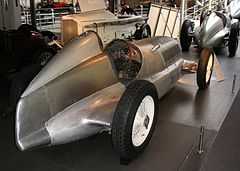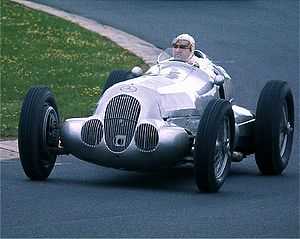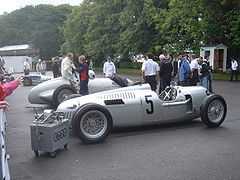Silver Arrows



Silver Arrows (German: Silberpfeil) was the name given by the press to Germany's dominant Mercedes-Benz and Auto Union Grand Prix motor racing cars between 1934 and 1939, and also later applied to the Mercedes-Benz Formula One and sports cars in 1954 and 1955.
For decades until the introduction of sponsorship liveries, each country had its traditional color in automobile racing. Italian race cars are still famous for their Rosso Corsa red, British ones are British racing green, French Bleu de France blue, etc.
German cars like the Blitzen Benz were white, as were the three Mercedes that won the 1914 French Grand Prix 1-2-3. On the other hand, Mercedes won the Italian Targa Florio with cars painted red in 1922 (Giulio Masetti) and 1924 (Christian Werner), blending in with the local competitors. The big supercharged 200 hp Mercedes-Benz SSKL with which Rudolf Caracciola won the 1931 Mille Miglia was called White Elephant.
Origin of the name
Story
In 1958 Alfred Neubauer's biography was published, and he described the origin of the Silver Arrows as being accidental. In 1934 the international governing body of motor sport prescribed a maximum weight limit of 750 kg for Grand Prix racing cars, excluding tyres and fuel. Neubauer said that when in spring 1934, the Mercedes-Benz team placed its new Mercedes-Benz W25 on the scrutineering scales prior to the Eifelrennen at the Nürburgring, it allegedly recorded 751 kg (1,656 lb). Racing manager Alfred Neubauer and his driver Manfred von Brauchitsch, who both later published their memoirs, claimed that they had the idea of removing all the white paint from the bodywork. The story continues that the next day the shining silver aluminium beneath was exposed and scrutineering was passed. After the 350 hp (260 kW) car of Von Brauchitsch won the race, the nickname Silver Arrow was born, according to this version.
Controversy
This story did not appear until 1958, and no reference to it has been found in contemporary sources. It has since been established that von Brauchitsch had raced a streamlined silver SSKL on the AVUS in 1932, which was called a Silver Arrow in live radio coverage. Also, in 1934, both Mercedes and Auto Union had entered the Avusrennen with silver cars, but neither had been able to start that race. The next big event was the 1934 Eifelrennen, but as few cars complying to the new rules were ready, it was held for Formule Libre, so weight was still not a race-critical issue at that time.[1]
By the 1930s, modern stressed-skin aircraft fuselage construction was already using polished and unpainted aluminium panels for streamlining and to save weight. Also the wealthy motor-racing fraternity would have been aware that in Heraldry, White and Silver are the same colour or 'tincture', described as 'Argent'; (similarly Yellow and Gold are both called 'Or').
Performance
 |
Mercedes-Benz W154
Mercedes-Benz W154 at Goodwood Festival of Speed 2009 |
| Problems playing this file? See media help. | |
By 1937, the supercharged engine of a Mercedes-Benz W125 attained an output of 646 hp (475 kW), a figure not exceeded in Grand Prix Racing until the early 1980s, when turbo-charged engines were common in Formula One. The Silver Arrows of Mercedes and Auto Union cars reached speeds of well over 300 kilometres per hour (186 mph) in 1937, and well over 400 km/h (249 mph) during land speed record runs.
The superiority of these vehicles in international motor racing established the term "Silver Arrow" as a legend, for example by usually winning the first race in which they were entered. The names Rudolf Caracciola, Bernd Rosemeyer, Hermann Lang, and later Stirling Moss and Juan Manuel Fangio, will always be associated with the eras of these racing cars.
Mercedes-Benz recalled its great past in the 1970s with rallye cars, and in the 1980s with the Sauber sportscars as well as the DTM touring cars, and also the multiple race winning Mercedes AMG F1 cars from 2010 onward.
Other car companies
.jpg)
Now a traditional color for road-cars in reference to the Silver Arrows, most German car companies have a shade of silver in their catalogues conforming to Silberpfeil-Grau, or Silver Arrow Grey.
However, the Audi and Mercedes-Benz are not the only ones who paint their cars in a silver color. Porsche has also inherited the tradition of silver arrows. But the BMW company still paints its cars in the traditional white color.
At the 1999 Le Mans 24 Hours, a total of seven Silver Arrows were entered in the Le Mans Prototype class:
- three Mercedes-Benz CLR
- two British-built LM-GT1 Audi R8C
- two Joest Racing LMP Audi R8R that scored third and fourth.
In 2010, Ross Brawn (of Formula One's Mercedes GP) introduced the new cars for that season as the new Silver Arrows, with Germans Nico Rosberg and 7 time world champion Michael Schumacher driving. In 2012, Nico Rosberg drove the W03 to victory at the Chinese Grand Prix to claim Mercedes' first victory in Formula One since 1955. Mercedes Benz's 2014 Formula One challenger, the W05 Hybrid (with drivers Lewis Hamilton & Nico Rosberg) is as of the British Grand Prix one of the most dominant cars in the sports history - winning (and leading every lap of) the first 7 races and only falling due to an ERS failure on both cars in the Canadian Grand Prix.
Further reading
- Chris Nixon, Racing the Silver Arrows: Mercedes-Benz versus Auto Union 1934-1939 (Osprey, London, 1986) pp. 30–37, 164-168
External links
- Grand Prix History, Die Silberpfeile
- The Silver Arrows
- The Silver Arrows 75th Anniversary, Carsguide Historical article
References
- ↑ , and (accessed on 10 March 2010)
| ||||||||||||||||||||||||||||||||||